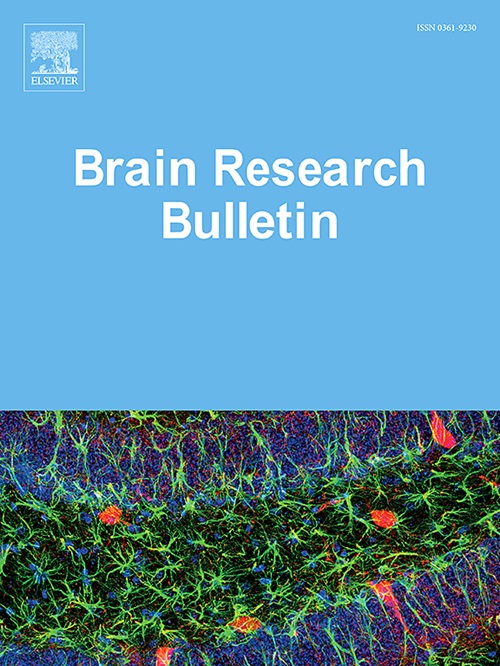脑卒中后吞咽困难患者味觉刺激下的吞咽皮层网络特征——来自fNIRS研究的见解。
IF 3.5
3区 医学
Q2 NEUROSCIENCES
引用次数: 0
摘要
脑卒中后吞咽困难患者与味觉刺激相关的吞咽皮质网络的改变尚不清楚。该研究的目的是利用功能性近红外光谱(fNIRS)研究味觉刺激下中风后吞咽困难患者脑功能活动的变化。在这项研究中,我们招募了28名卒中后吞咽困难患者和24名年龄匹配的健康对照。分别完成吞咽评估、静息状态和吞咽任务相关fNIRS测试。我们发现,与健康对照组相比,患者在吞水任务时的左、右辅助运动区(SMA)和吞盐水任务时的左SMA和右初级感觉区(S1)的脑激活显著降低,在纠正错误发现率(FDR)后,只有左SMA在吞盐水任务中仍具有显著性。我们将14名健康对照和13名患者纳入亚组分析,探讨偏好味觉对吞咽网络的影响,我们观察到患者组在吞咽水时右侧S1的脑激活显著降低(p=0.008,校正FDR),在偏好味觉刺激下各组间所有通道的激活强度相似。与健康对照组相比,患者半球感觉运动区之间的功能连通性(FC)显著降低。我们的研究显示,与健康对照组相比,吞咽困难患者在盐水吞咽任务中左侧SMA的激活明显减少。中风后的吞咽困难患者表现出与吞咽相关的半球感觉运动区之间的相互作用受损。酸、甜和偏好味觉刺激具有增强大脑可塑性的潜力,这可能为开发卒中后吞咽困难的新策略提供新的见解。本文章由计算机程序翻译,如有差异,请以英文原文为准。
Swallowing cortical network features under taste stimulation for patients with post stroke dysphagia—Insights from a fNIRS study
The alterations in the swallowing cortical network associated with taste stimulation in patients with post-stroke dysphagia remain unclear. The aim of the study was to investigate the alterations in brain functional activity among individuals with post-stroke dysphagia under taste stimuli using functional near-infrared spectroscopy (fNIRS). We recruited 28 patients with post-stroke dysphagia and 24 age-matched healthy controls in this study. Each of them completed swallowing evaluation, resting-state and swallowing task-related fNIRS test. We found that the brain activation of patients significantly decreased in the left and right supplemental motor area (SMA) for water swallowing task and the left SMA and right primary sensory area (S1) for salty water swallowing, compared with healthy controls, only the left SMA remained significant for salty water swallowing after False Discovery Rate (FDR) correction. Fourteen healthy controls and 13 patients were included in the subgroup analysis, to explore the influences of preferred taste on swallowing network, we observed that the brain activation in the right S1 was significantly reduced during water swallowing in patient group (p = 0.008, with FDR corrected), all channels showed similar strengths in the activation under preferred taste stimulus between the groups. Functional connectivity (FC) between hemispheric sensorimotor areas were significantly decreased in patients compared with healthy controls. Our investigation revealed a noteworthy reduction in the activation of the left SMA during the salty water swallowing task in patients with dysphagia when compared to the healthy control group. The dysphagic patients following stroke exhibited impaired interaction between hemispheric sensorimotor areas associated with swallowing. Sour, sweet, and preferred taste stimulation have the potential to enhance brain plasticity, which may offer new insights for developing novel strategies for post-stroke dysphagia.
求助全文
通过发布文献求助,成功后即可免费获取论文全文。
去求助
来源期刊

Brain Research Bulletin
医学-神经科学
CiteScore
6.90
自引率
2.60%
发文量
253
审稿时长
67 days
期刊介绍:
The Brain Research Bulletin (BRB) aims to publish novel work that advances our knowledge of molecular and cellular mechanisms that underlie neural network properties associated with behavior, cognition and other brain functions during neurodevelopment and in the adult. Although clinical research is out of the Journal''s scope, the BRB also aims to publish translation research that provides insight into biological mechanisms and processes associated with neurodegeneration mechanisms, neurological diseases and neuropsychiatric disorders. The Journal is especially interested in research using novel methodologies, such as optogenetics, multielectrode array recordings and life imaging in wild-type and genetically-modified animal models, with the goal to advance our understanding of how neurons, glia and networks function in vivo.
 求助内容:
求助内容: 应助结果提醒方式:
应助结果提醒方式:


